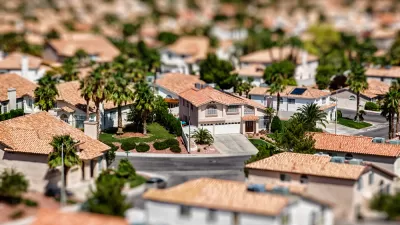A closer look at the data reveals a country that continues to sprawl.

Jed Kolko lays out his argument for a post a New York Times Upshot article:
Be skeptical when you hear about the return to glory of the American city — that idealized vision of rising skyscrapers and bustling, dense downtowns. Contrary to perception, the nation is continuing to become more suburban, and at an accelerating pace. The prevailing pattern is growing out, not up, although with notable exceptions.
According to Kolko's analysis, "[r]ural areas are lagging metropolitan areas in numerous measures, but within metro areas the suburbs are growing faster in both population and jobs."
Kolko presents a number of infographics to make an unavoidable point: most metropolitan areas in the country have become less urban (defined by density) during this decade. Exceptions include Seattle, Chicago, and Minneapolis at the top of the list of cities growing the most dense between 2010 and 2016. Meanwhile San Antonio, Austin, and Oklahoma City lead the trend toward less dense living. Kolko also locates a trend within the urbanization trend: already dense metros are getting denser. Thus, Kolko forgives those propagating the perception that the entire country is urbanizing: "metro areas that are urbanizing have more than their fair share of urban planners, including Seattle, Minneapolis, Washington and Boston. Those who write about, advocate for and choose to live in cities really do see more urbanization around them."
Kolko's argument echoes that of an earlier article by Alon Levy, which took San Diego County, in California, as its case study for the same suburbanization trend.
FULL STORY: Seattle Climbs but Austin Sprawls: The Myth of the Return to Cities

Maui's Vacation Rental Debate Turns Ugly
Verbal attacks, misinformation campaigns and fistfights plague a high-stakes debate to convert thousands of vacation rentals into long-term housing.

Planetizen Federal Action Tracker
A weekly monitor of how Trump’s orders and actions are impacting planners and planning in America.

San Francisco Suspends Traffic Calming Amidst Record Deaths
Citing “a challenging fiscal landscape,” the city will cease the program on the heels of 42 traffic deaths, including 24 pedestrians.

Defunct Pittsburgh Power Plant to Become Residential Tower
A decommissioned steam heat plant will be redeveloped into almost 100 affordable housing units.

Trump Prompts Restructuring of Transportation Research Board in “Unprecedented Overreach”
The TRB has eliminated more than half of its committees including those focused on climate, equity, and cities.

Amtrak Rolls Out New Orleans to Alabama “Mardi Gras” Train
The new service will operate morning and evening departures between Mobile and New Orleans.
Urban Design for Planners 1: Software Tools
This six-course series explores essential urban design concepts using open source software and equips planners with the tools they need to participate fully in the urban design process.
Planning for Universal Design
Learn the tools for implementing Universal Design in planning regulations.
Heyer Gruel & Associates PA
JM Goldson LLC
Custer County Colorado
City of Camden Redevelopment Agency
City of Astoria
Transportation Research & Education Center (TREC) at Portland State University
Jefferson Parish Government
Camden Redevelopment Agency
City of Claremont





























